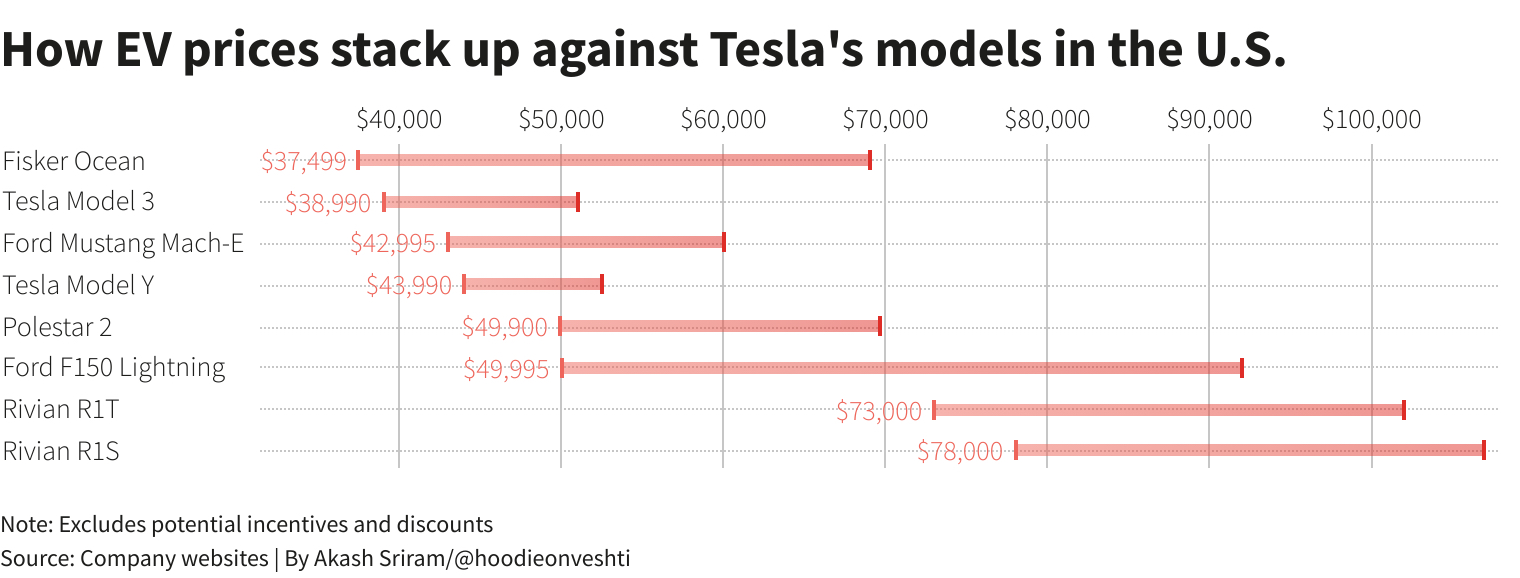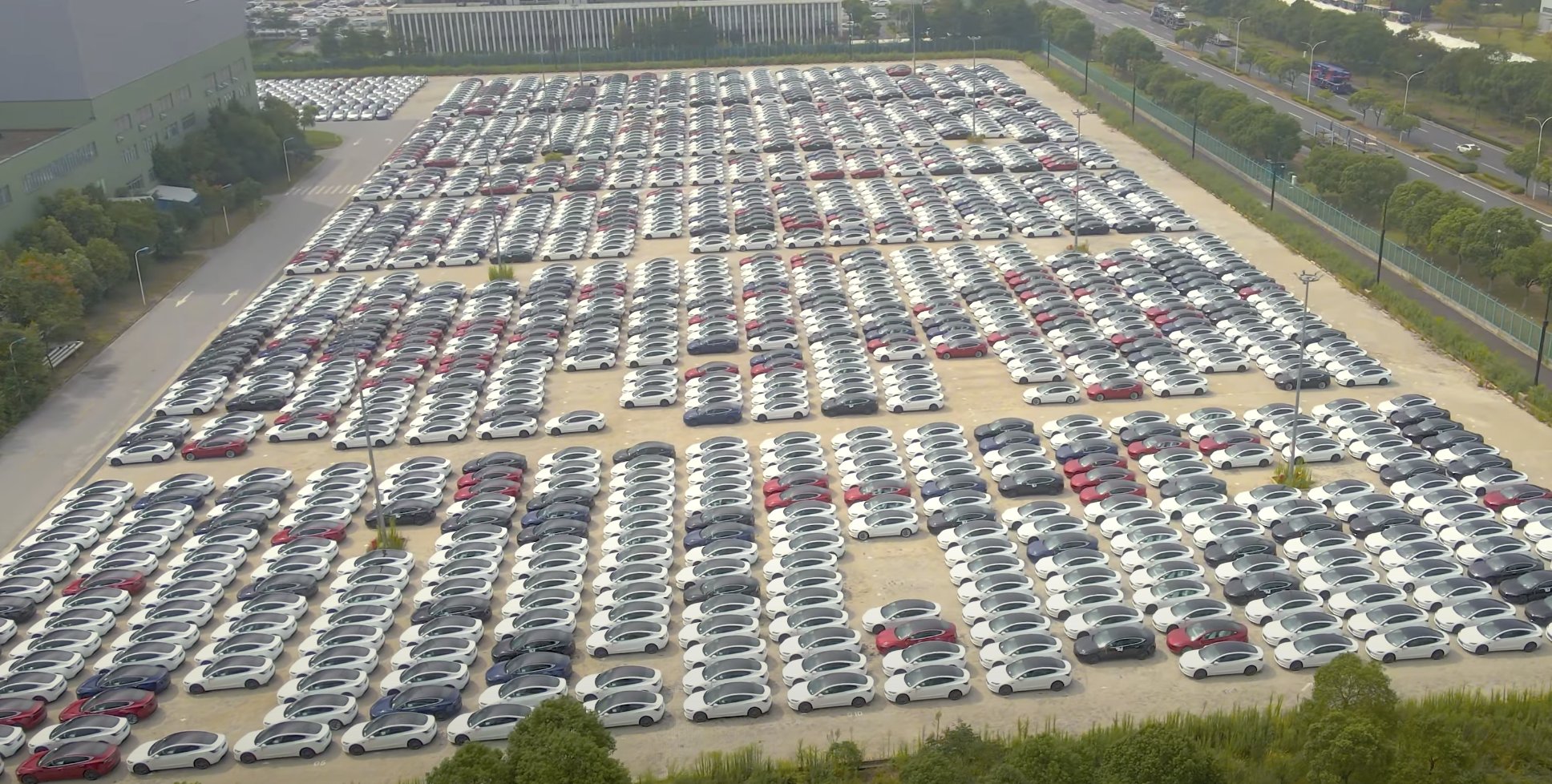Sales of electric vehicles (EVs) surpassed an important milestone in Q3, marking a record quarter as the options available to consumers continue to increase.
EV market sales in the U.S. reached 300,000 during the third quarter, according to data from Cox Automotive in a report from Reuters this week. The increase represents an almost 50-percent increase from last year’s Q3, while overall EV adoption rose to 7.9 percent in the same quarter.
Dominant EV leader Tesla fell short of Q3 analyst delivery estimates, as announced earlier this month, and the automaker’s market share dropped from 62 to 50 percent in Q3. During the Q2 earnings call earlier this year, the automaker also predicted a drop in production during the third quarter due to factory upgrades.
Tesla has also stirred what many have termed a “price war” by reducing prices across its lineup throughout much of the year.
Most recently, Tesla cut the price of its Model 3 sedan and Model Y SUV just this week, which is the latest reduction after the automaker launched lineup-wide price cuts in January with more following in the months since. Tesla also began offering a more affordable Model Y configuration earlier this month.
Tesla price cuts push EV market toward affordability with broader influence
The result has put pressure on other automakers, as they have been forced to either cut prices on their EVs or miss out on buyers seeking the best deal. An increase in electric options and lower prices on EVs are expected to boost demand, and the Cox report showed that average EV prices dropped to $50,683 in September from $52,212 in August.
“Higher inventory levels, more product availability, and downward pricing pressure have helped spur continued linear growth of EV sales in the U.S. market,” Cox said in the Thursday report.
Credit: Reuters Credit: Reuters

The news comes after the price cuts have brought the price of the Tesla Model 3 and the Model Y beneath the average car price in the U.S. this year. It also comes ahead of Tesla’s initial deliveries of the highly anticipated Cybertruck. Although the automaker’s market share decreased in Q3, the increase of overall EV deliveries is considered a positive for the automaker.
In the past, Tesla CEO Elon Musk has emphasized the company’s goal to accelerate the world’s transition to EVs, even embracing increased competition as a means to that end.
“So, for us, we’re very philosophically motivated. We care about the advancement of electric vehicles,” Musk said in an interview in 2015. “To that end, we also open sourced all of our patents. So, we said any car company can use our technology — it’s no problem. They don’t even have to pay a fee to us.”
What are your thoughts? Let me know at zach@teslarati.com, find me on X at @zacharyvisconti, or send your tips to us at tips@teslarati.com.

Elon Musk
Elon Musk and Tesla AI Director share insights after empty driver seat Robotaxi rides
The executives’ unoccupied tests hint at the rapid progress of Tesla’s unsupervised Robotaxi efforts.

Tesla CEO Elon Musk and AI Director Ashok Elluswamy celebrated Christmas Eve by sharing personal experiences with Robotaxi vehicles that had no safety monitor or occupant in the driver’s seat. Musk described the system’s “perfect driving” around Austin, while Elluswamy posted video from the back seat, calling it “an amazing experience.”
The executives’ unoccupied tests hint at the rapid progress of Tesla’s unsupervised Robotaxi efforts.
Elon and Ashok’s firsthand Robotaxi insights
Prior to Musk and the Tesla AI Director’s posts, sightings of unmanned Teslas navigating public roads were widely shared on social media. One such vehicle was spotted in Austin, Texas, which Elon Musk acknowleged by stating that “Testing is underway with no occupants in the car.”
Based on his Christmas Eve post, Musk seemed to have tested an unmanned Tesla himself. “A Tesla with no safety monitor in the car and me sitting in the passenger seat took me all around Austin on Sunday with perfect driving,” Musk wrote in his post.
Elluswamy responded with a 2-minute video showing himself in the rear of an unmanned Tesla. The video featured the vehicle’s empty front seats, as well as its smooth handling through real-world traffic. He captioned his video with the words, “It’s an amazing experience!”
Towards Unsupervised operations
During an xAI Hackathon earlier this month, Elon Musk mentioned that Tesla owed be removing Safety Monitors from its Robotaxis in Austin in just three weeks. “Unsupervised is pretty much solved at this point. So there will be Tesla Robotaxis operating in Austin with no one in them. Not even anyone in the passenger seat in about three weeks,” he said. Musk echoed similar estimates at the 2025 Annual Shareholder Meeting and the Q3 2025 earnings call.
Considering the insights that were posted Musk and Elluswamy, it does appear that Tesla is working hard towards operating its Robotaxis with no safety monitors. This is quite impressive considering that the service was launched just earlier this year.
Elon Musk
Starlink passes 9 million active customers just weeks after hitting 8 million
The milestone highlights the accelerating growth of Starlink, which has now been adding over 20,000 new users per day.

SpaceX’s Starlink satellite internet service has continued its rapid global expansion, surpassing 9 million active customers just weeks after crossing the 8 million mark.
The milestone highlights the accelerating growth of Starlink, which has now been adding over 20,000 new users per day.
9 million customers
In a post on X, SpaceX stated that Starlink now serves over 9 million active users across 155 countries, territories, and markets. The company reached 8 million customers in early November, meaning it added roughly 1 million subscribers in under seven weeks, or about 21,275 new users on average per day.
“Starlink is connecting more than 9M active customers with high-speed internet across 155 countries, territories, and many other markets,” Starlink wrote in a post on its official X account. SpaceX President Gwynne Shotwell also celebrated the milestone on X. “A huge thank you to all of our customers and congrats to the Starlink team for such an incredible product,” she wrote.
That growth rate reflects both rising demand for broadband in underserved regions and Starlink’s expanding satellite constellation, which now includes more than 9,000 low-Earth-orbit satellites designed to deliver high-speed, low-latency internet worldwide.
Starlink’s momentum
Starlink’s momentum has been building up. SpaceX reported 4.6 million Starlink customers in December 2024, followed by 7 million by August 2025, and 8 million customers in November. Independent data also suggests Starlink usage is rising sharply, with Cloudflare reporting that global web traffic from Starlink users more than doubled in 2025, as noted in an Insider report.
Starlink’s momentum is increasingly tied to SpaceX’s broader financial outlook. Elon Musk has said the satellite network is “by far” the company’s largest revenue driver, and reports suggest SpaceX may be positioning itself for an initial public offering as soon as next year, with valuations estimated as high as $1.5 trillion. Musk has also suggested in the past that Starlink could have its own IPO in the future.
News
NVIDIA Director of Robotics: Tesla FSD v14 is the first AI to pass the “Physical Turing Test”
After testing FSD v14, Fan stated that his experience with FSD felt magical at first, but it soon started to feel like a routine.

NVIDIA Director of Robotics Jim Fan has praised Tesla’s Full Self-Driving (Supervised) v14 as the first AI to pass what he described as a “Physical Turing Test.”
After testing FSD v14, Fan stated that his experience with FSD felt magical at first, but it soon started to feel like a routine. And just like smartphones today, removing it now would “actively hurt.”
Jim Fan’s hands-on FSD v14 impressions
Fan, a leading researcher in embodied AI who is currently solving Physical AI at NVIDIA and spearheading the company’s Project GR00T initiative, noted that he actually was late to the Tesla game. He was, however, one of the first to try out FSD v14.
“I was very late to own a Tesla but among the earliest to try out FSD v14. It’s perhaps the first time I experience an AI that passes the Physical Turing Test: after a long day at work, you press a button, lay back, and couldn’t tell if a neural net or a human drove you home,” Fan wrote in a post on X.
Fan added: “Despite knowing exactly how robot learning works, I still find it magical watching the steering wheel turn by itself. First it feels surreal, next it becomes routine. Then, like the smartphone, taking it away actively hurts. This is how humanity gets rewired and glued to god-like technologies.”
The Physical Turing Test
The original Turing Test was conceived by Alan Turing in 1950, and it was aimed at determining if a machine could exhibit behavior that is equivalent to or indistinguishable from a human. By focusing on text-based conversations, the original Turing Test set a high bar for natural language processing and machine learning.
This test has been passed by today’s large language models. However, the capability to converse in a humanlike manner is a completely different challenge from performing real-world problem-solving or physical interactions. Thus, Fan introduced the Physical Turing Test, which challenges AI systems to demonstrate intelligence through physical actions.
Based on Fan’s comments, Tesla has demonstrated these intelligent physical actions with FSD v14. Elon Musk agreed with the NVIDIA executive, stating in a post on X that with FSD v14, “you can sense the sentience maturing.” Musk also praised Tesla AI, calling it the best “real-world AI” today.










